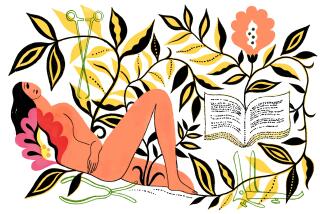The Delicate Reminders of a Tortured Past
Beverley Jackson, having just described how millions of Chinese women had their feet maimed and miniaturized in the name of beauty, asks her Santa Monica audience, “How many women here today have pointed toes, high heels--and their feet hurt?”
She’s made her point: “Essentially, foot-binding is about sex.” And, she adds, “Until our liberation by Reeboks and Nikes, we were just as bad, in our own way.”
Jackson--size 10B--unravels the mysteries of those frightfully fettered 3-inch-long feet, revered for 1,000 years by Chinese men as “little lotus blossoms,” in “Splendid Slippers / Size One Narrow,” to be published in 1997.
Myth No. 1: Bound feet signified class and wealth. The custom started in the palace in the 10th century, Jackson says, but, “It worked its way down. By the 17th century, the poorest farmer would bind his daughter’s feet to get her a richer husband.”
But, alas, this didn’t guarantee the poor girl a life of luxury. Unlike her well-born sisters, who spent their hobble-footed days doing embroidery and being carried about in sedan chairs, she might still have to work in the fields.
So why would any woman trade a serviceable pair of feet for a lifetime of pain?
Those little feet turned Chinese men on. It wasn’t just the feet--which husbands would sniff and fondle and nibble. A woman with bound feet developed a “lotus gait” that tightened her pelvic muscles. “The men said it was like always making love to a virgin,” Jackson explains.
When lecturing, Jackson, for 24 years society columnist for the Santa Barbara News-Press, occasionally finds some people a bit squeamish as she tells how those tiny feet got that way.
It wasn’t pretty. When a girl was about 6, she’d be taken--often crying and screaming--to a foot-binding stool. For softening up, her feet might be soaked in a broth of boiled monkey bones. Then a cotton bandage, about 3 inches wide and 10 feet long, would be wrapped around each foot in a figure-eight.
Only the big toes were left free. As the feet were rebound, tighter and tighter, over about two years, the child’s other toes were broken and forced flat against the soles, the arches broken, the heels drawn forward. Picture a fist turned on end, the thumb representing the big toe.
“There are still a million women today whose feet were bound,” Jackson says--virtually every Han (native) Chinese woman born before 1943.
Although women of other cultures have mutilated themselves--displacing their internal organs with tight corsets, enlarging their breasts or otherwise tinkering with nature, only the Chinese did true foot-binding.
Jackson has uncovered intriguing lore. One story has it that binding began by decree of an early emperor whose empress had a club foot. More likely, it began about AD 980 with a court concubine who’d wrap her feet in silk and dance on her toes for her prince.
At her Santa Barbara home, Jackson displays 3-inch slippers from her collection of 140 pairs. It began when, on her first visit to China in 1975, she bought an antique robe. Soon, she was collecting robes and researching the lives of the women who had worn them. But at her lectures, “All anyone ever asked about were eunuchs and bound feet.”
She began collecting tiny slippers. She has exquisitely embroidered white mourning slippers and red boudoir slippers with tooth-marked toes.
“It’s really yin and yang, such beauty covering such ugliness,” Jackson says. Understandably, Chinese women--with the exception of those with love for sale-- never bared those feet and their men “thought they were these beautiful little pink dumplings, when they were these terrible monstrosities.”
The Manchus, who invaded China in 1644, forbade their women to bind, eager to keep cultural separation. But Manchu women simulated the “lotus gait” by wearing shoes with high platforms. Although bound feet were taboo inside the Forbidden City, eunuchs reported seeing tiny red slippers, presumably belonging to prostitutes, under royal bedcovers.
Despite campaigns by American missionaries and others, foot-binding flourished until banned by the Communists in 1949. They equated binding with decadence and, Jackson says, “They didn’t make that long march to have women who couldn’t walk.” Or work. Overnight, women with bound feet became objects of ridicule.
Elderly women interviewed for Jackson’s books continue binding, because leaving their feet unbound is excruciatingly painful. One Chinese factory still makes simple slippers, size 1 / narrow. Antique slippers--many of them collected and preserved by diplomats’ wives--today fetch up to $1,000 a pair.
Spilling the Royal Beans
Sarah Bradford--a.k.a. the Viscountess Bangor--stands before a grand piano in a stately Pasadena living room, smiles and says, “I am the spiller of the queen’s beans.”
A line she’d purloined from a British tabloid headline, she tells the appreciative gathering of the English Speaking Union.
Why the Fleet Street frenzy about “a respectable middle-aged biographer like myself?” Because her book, “Elizabeth,” just out from Farrar, Straus & Giroux to mark the monarch’s 70th birthday, “dares to tell the truth about the queen’s marriage.”
That truth, she writes, is that Prince Philip, 74, has been carrying on discreet “flirtations and relationships” with numerous beautiful, young and titled (though unnamed) women, including a princess, a duchess and two countesses.
“Theirs is a very royal marriage,” she says. Elizabeth “sees, but she does not want to know.” And, Philip is not a man “to fall hopelessly in love; his affairs make no difference to a marriage as firm and indeed fond as theirs.”
But, on the book tour, it’s not Philip’s flings that most intrigue people. They ask: Will the monarchy survive? Will Prince Charles be king?
Yes, the royals will endure, Bradford says, though decent middle-class Brits are fed up with scandal and “the media wars between the Waleses.” And, she says, “There’s no way Charles will not be king, unless he murders somebody. Even if he were mad . . . he will be King Charles III if he survives his mother.”
Will Camilla Parker-Bowles be his queen? “I rather hope not,” Bradford says, but there’s nothing to stop him. “The king is above the law. Edward the VIII could have married Mrs. Simpson” without abdicating “had he not asked permission.”
* This weekly column chronicles the people and small moments that define life in Southern California. Reader suggestions are welcome.






